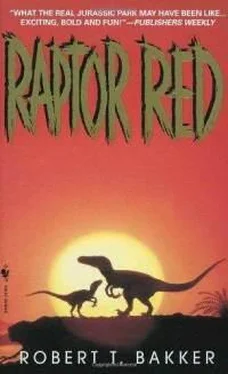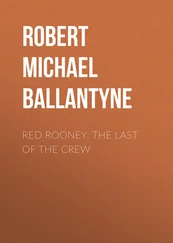I’ll try it. Raptor Red looks out over the slope, now churned into a low-viscosity mixture of red mud and slush. She grips the edge with her hindclaws, lowers her body, and—
Whump! She’s shoved by her sister and falls on her side. The mud-slush feels smooth as Raptor Red goes downhill. She rolls on her back and is surprised how trees look when seen from this position.
It’s an exhilarating, scary, strange, fast, spinning, upside-down feeling.
She likes it.
It is a very windy day when the raptor pack meets the whip-tail brontosaur. Whenever the dark clots of clouds block the solar heat, the air becomes chilly and inhospitable. The air is clear and bright, and as long as they stay in the sun, the raptor sisters feel comfortable.
The raptors see the whip-tail from two miles away - a dark mass moving alone in a mountain meadow. They try to sniff out some target data -Who is this potential prey? Is it too strong for an attack? Is it injured?
The scent that wafts up from the whip-tail makes Raptor Red pause. It is like Astrodon scent - but, on the other hand, it isn’t. Raptor Red knows only one kind of brontosaurian - Astrodon itself - and she knows how to attack these immense vegetarians. If that were an astrodon down there, she and her sister could probably handle it.
But the scent tells her to be careful, to expect something new. That is an unknown Astrodon variation.
As she stands on tiptoes, trying to get a better look, she becomes aware that she is alone. Her sister has already gone downhill to begin the attack.
Raptor Red has a bad feeling about this attack. She screeches a short alarm that says, Wait - wait for me. But her sister doesn’t wait.
Raptor Red bounds down the hill to catch up.
When Raptor Red sees the whip-tail up close through the shrubs, the big dino is staring right back at her. Raptor Red doesn’t like this at all. It’s a universal rule: Predators of all ages are naturally suspicious of prey who don’t appear to be scared. Self-confident prey are often those who have extra skill and strength in defense.
Clearly the whip-tail is not rattled by the prospect of battling two Utahraptors. It sees Raptor Red’s sister and swivels its head back and forth, keeping track of both raptors.
The whip-tail moves deliberately out away from the treeline, toward the middle of the open meadow, where fresh snow covers the tops of ferns and conifer seedlings.
Raptor Red feels even more uneasy. The whip-tail seems to be setting up a defense that the raptors haven’t seen before.
Raptor Red gives a low gurgling call to her sister, who looks back briefly, then circles around the far side of the whip-tail. The older chick stands trembling next to Raptor Red, afraid to join her mother, afraid to stay.
The whip-tail makes a quarter-turn so its shoulders are facing away from Raptor Red and its broadside is opposite her sister. At a sudden zipping sound, Raptor Red ducks instinctively. A conifer branch five feet above her nose is severed from its trunk and falls heavily on top of Raptor Red’s back. The older chick crouches in terror.
Raptor Red recoils, jumping backward. What was THAT? her brain demands of her senses. Let’s get out of here - there are plenty of iguanodons to hunt - let’s leave this strange monster alone.
But before she can run away, Raptor Red sees a blur of tough, flexible tissue whizzing just inches above her eyes. A slab of bark is loosened from a thick conifer trunk and slides down to the ground.
The whip-tail has moved backward, closing the distance between itself and Raptor Red. It’s whooshing its tail back and forth, holding the twenty-foot-long tip high off the ground. Raptor Red recognizes the tail as the deadly weapon that is cutting branches off trees.
The whip-tail has muscles of exceptional power in the base of the tail, just aft of its hips. When these muscles twitch, the wave of contractile force passes down the tail, out to the thin whiplash tip, amplifying the movement. Just a few degrees of flexure at the rump become a twenty-foot arc at the tail extremity.
It’s a great weapon for hitting targets far from the whip-tail’s torso. The tail tip can travel at hundreds of miles an hour, and when it hits a predator’s body, the kinetic energy will cut flesh and stun limb joints.
This whip-defense gave the whip-tail clan great success in their evolutionary past. Now they’re reduced to scattered remnant populations, their ancestral dynasty ruined by immigrant disease. But as individuals, the whip-tails are still the most dangerous herbivores ever to face a dino-predator.
Raptor Red grew up in environments devoid of whip-tails, and her species has no hardwired mode of behavior to deal with their tail-defense.
Wise predators are not reckless. Predators who live long and raise many chicks are not bombastic fools who rush into every dangerous situation. Evolution has not favored raptor genes that give their owners bravado.
To be a Darwinian success, it’s absolutely necessary to know when to run away.
And Raptor Red knows it’s running-away time right now. She can’t figure out the tail-defense and doesn’t want to hang around until she does.
Her sister has reached the same conclusion. She’s skulking back up the wooded slope, head down, mostly hidden in the underbrush.
The raptor sisters are halfway up the slope when they hear a high-pitched alarm call. They stop dead in their tracks and turn around.
Screeeeeeeee! It’s a Utahraptor, and it’s a chick.
The raptor sisters stand as tall as they can and look down. The giant whip-tail has followed them to the base of the slope. The older chick is still on the other side of the meadow, separated from Raptor Red and her sister by the whip-tail.
Raptor Red sees the chick zigzagging in panic, trying to get past the whip-tail. A quick flip of the whip-tail’s whip, and the chick falls over, then gets up.
Dumb, dumb chick, Raptor Red says to herself. Go the other way, go around.
But the chick tries to come straight up the slope, ducking low to avoid the whip-tail. The giant vegetarian moves sideways with surprising agility and flicks its tail tip at the chick.
A long line of snow explodes just short of the chick, showing that the whip-tail missed by inches.
'SCREEEEEE!" Raptor Red flinches at the ear-splitting call of anger emitted by her sister. She watches in horror as her sister goes flying down the slope directly at the whip-tail.
Don’t DO that, Raptor Red thinks.
The whip-tail backs off. Maybe my sister was right, Raptor Red thinks. She starts down the slope to join the attack.
The chick, befuddled by fear, runs in circles behind the whip-tail.
Raptor Red crashes through the line of conifers at the edge of the meadow. She waves her arms and hoots. Then she stops. The whip-tail is dead ahead, only twenty-five feet ahead. And it’s moving toward her.
WHUMP! Raptor Red is knocked down on her side by a heavy, close-range tail hit. She tries to get up, but an excruciating pain in her knee brings her down into the snow. She tries again. No good. Her knee is partly dislocated.
She looks up. The whip-tail is coming closer, walking like a giant crab, keeping its broadside toward her, the giant tail twitching ominously.
Raptor Red crawls back under a conifer.
TTTTTWUNK! The whip-tail aims a blow accurately. Raptor Red is saved by a heavy branch that absorbs the hit. Gobs of sap appear where the bark has been crushed by the tail.
The whip-tail turns and moves a dozen steps away. Through the snow and branches Raptor Red sees a fast flutter of raptor feet. Her sister is attacking from the far side. The older chick hesitates, then joins her mother in the counterassault.
Читать дальше












